Analysis of Virtual Meeting in Organizational Development Report
VerifiedAdded on 2022/10/18
|7
|1314
|186
Report
AI Summary
This report examines the role of virtual meetings in organizational development. It begins with an introduction to virtual meetings and their reliance on communication technologies like email, telephonic conversations, and video conferences. The report then explores the advantages, such as improved connectivity, cost savings, faster file sharing, and environmental benefits, as well as the disadvantages, including technical failures, lack of interpersonal interaction, distractions, and security risks. The report also includes case studies of how companies like General Electric (GE) and Procter & Gamble (P&G) leverage virtual teams for training, communication, and market analysis. GE uses virtual classrooms and interactive sessions, while P&G utilizes virtual tools for customer engagement and market data collection. The report concludes that while virtual meetings offer significant benefits, organizations must address the associated risks to achieve their goals.
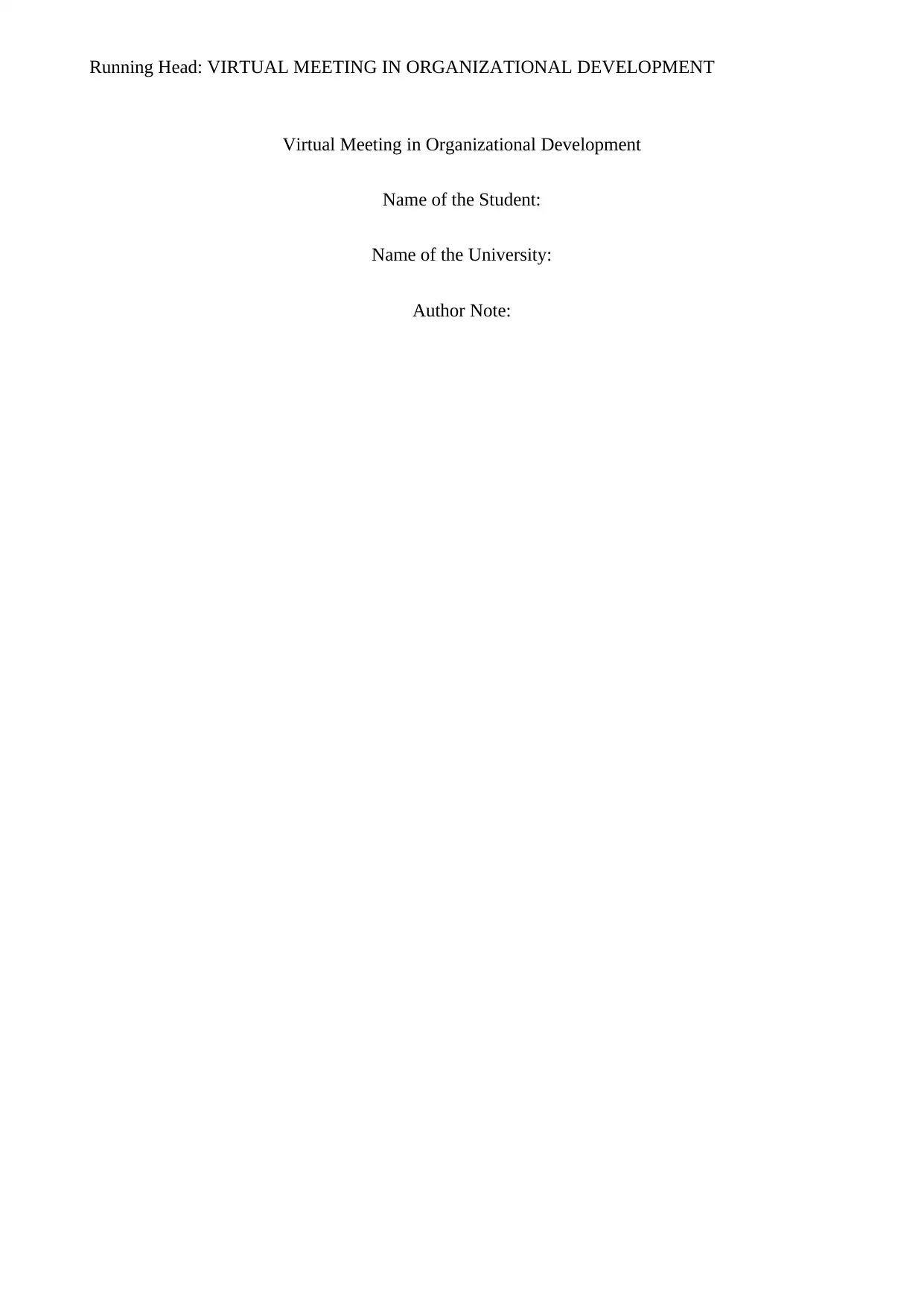
Running Head: VIRTUAL MEETING IN ORGANIZATIONAL DEVELOPMENT
Virtual Meeting in Organizational Development
Name of the Student:
Name of the University:
Author Note:
Virtual Meeting in Organizational Development
Name of the Student:
Name of the University:
Author Note:
Paraphrase This Document
Need a fresh take? Get an instant paraphrase of this document with our AI Paraphraser
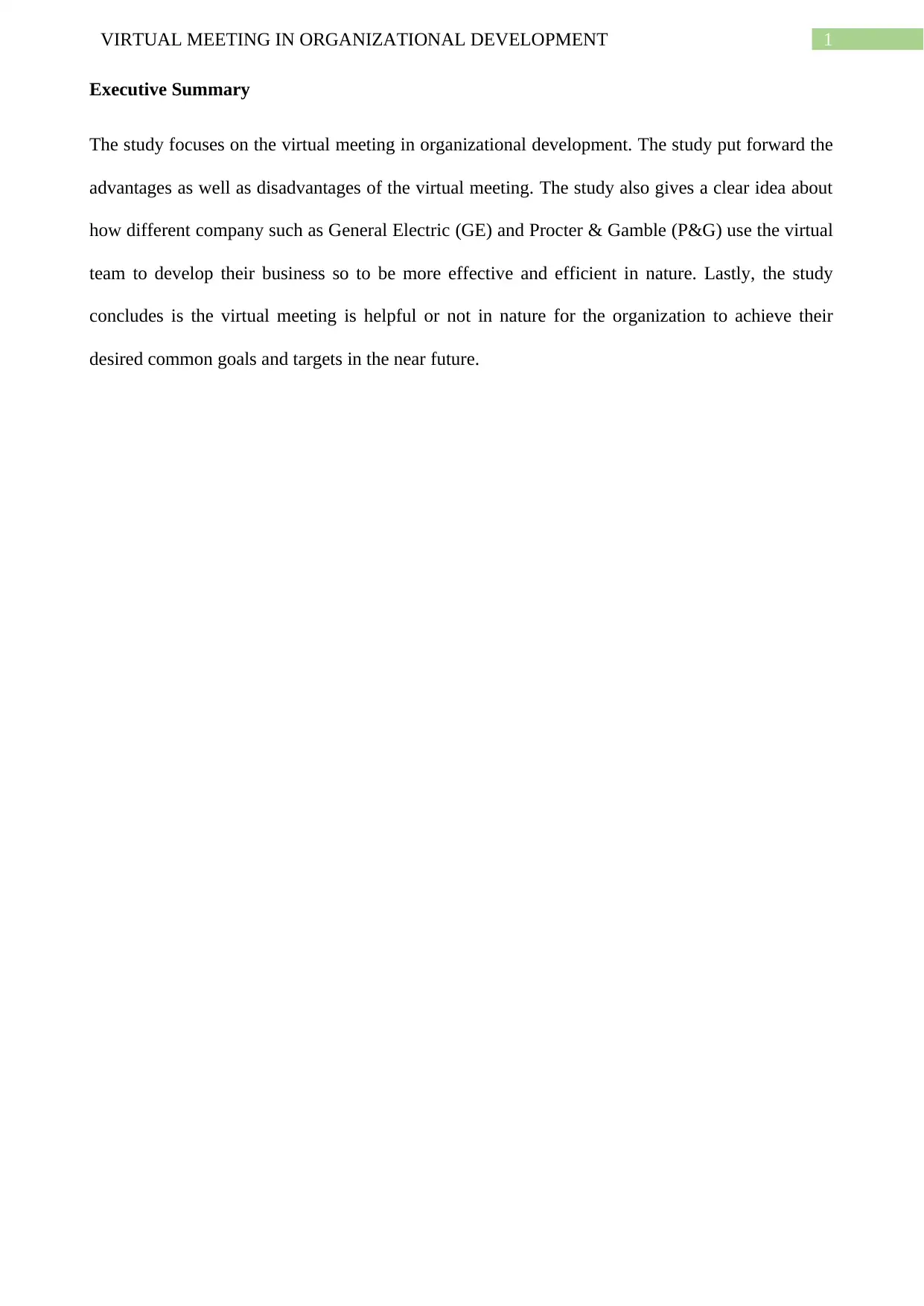
1VIRTUAL MEETING IN ORGANIZATIONAL DEVELOPMENT
Executive Summary
The study focuses on the virtual meeting in organizational development. The study put forward the
advantages as well as disadvantages of the virtual meeting. The study also gives a clear idea about
how different company such as General Electric (GE) and Procter & Gamble (P&G) use the virtual
team to develop their business so to be more effective and efficient in nature. Lastly, the study
concludes is the virtual meeting is helpful or not in nature for the organization to achieve their
desired common goals and targets in the near future.
Executive Summary
The study focuses on the virtual meeting in organizational development. The study put forward the
advantages as well as disadvantages of the virtual meeting. The study also gives a clear idea about
how different company such as General Electric (GE) and Procter & Gamble (P&G) use the virtual
team to develop their business so to be more effective and efficient in nature. Lastly, the study
concludes is the virtual meeting is helpful or not in nature for the organization to achieve their
desired common goals and targets in the near future.
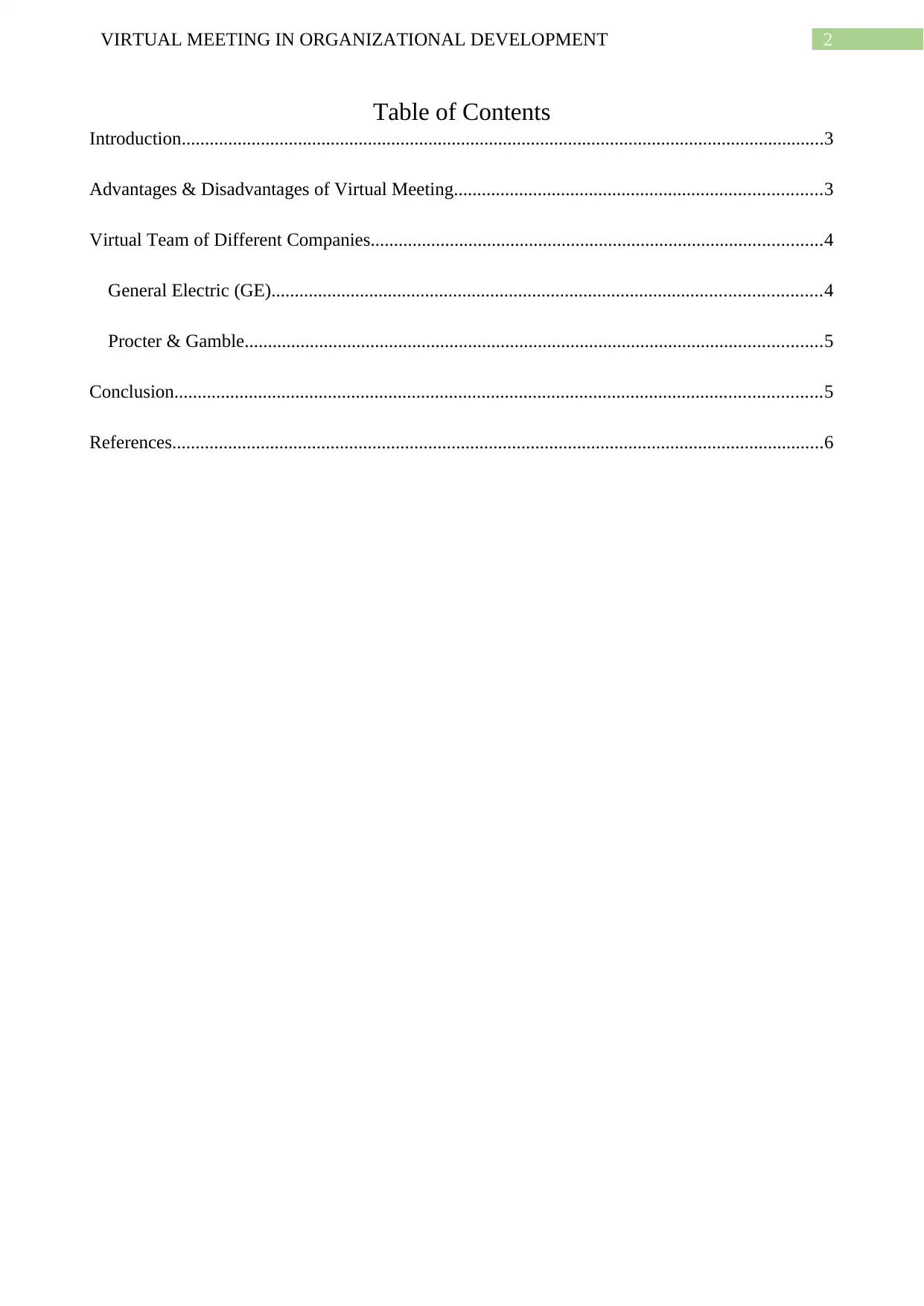
2VIRTUAL MEETING IN ORGANIZATIONAL DEVELOPMENT
Table of Contents
Introduction..........................................................................................................................................3
Advantages & Disadvantages of Virtual Meeting...............................................................................3
Virtual Team of Different Companies.................................................................................................4
General Electric (GE)......................................................................................................................4
Procter & Gamble............................................................................................................................5
Conclusion...........................................................................................................................................5
References............................................................................................................................................6
Table of Contents
Introduction..........................................................................................................................................3
Advantages & Disadvantages of Virtual Meeting...............................................................................3
Virtual Team of Different Companies.................................................................................................4
General Electric (GE)......................................................................................................................4
Procter & Gamble............................................................................................................................5
Conclusion...........................................................................................................................................5
References............................................................................................................................................6
⊘ This is a preview!⊘
Do you want full access?
Subscribe today to unlock all pages.

Trusted by 1+ million students worldwide
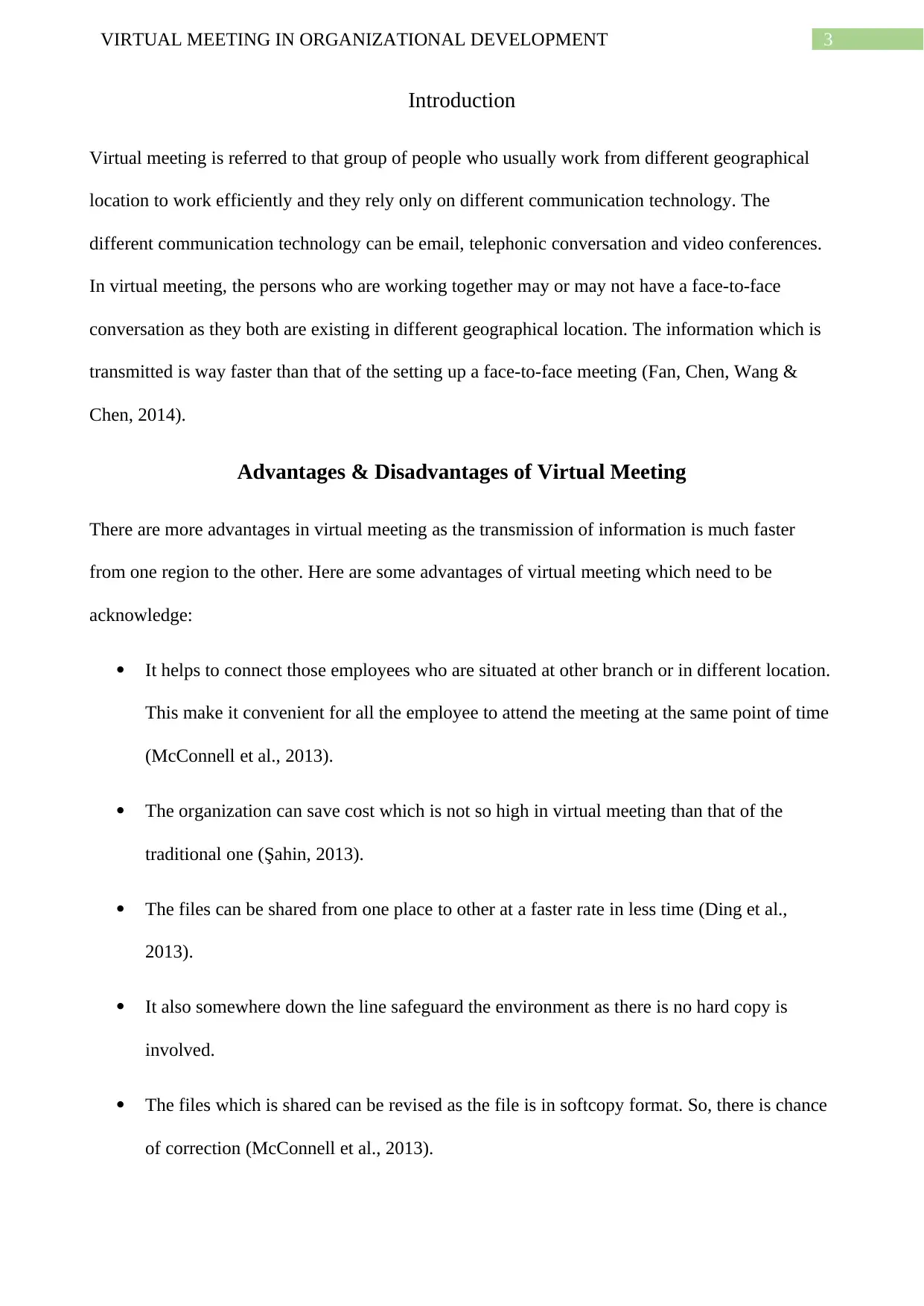
3VIRTUAL MEETING IN ORGANIZATIONAL DEVELOPMENT
Introduction
Virtual meeting is referred to that group of people who usually work from different geographical
location to work efficiently and they rely only on different communication technology. The
different communication technology can be email, telephonic conversation and video conferences.
In virtual meeting, the persons who are working together may or may not have a face-to-face
conversation as they both are existing in different geographical location. The information which is
transmitted is way faster than that of the setting up a face-to-face meeting (Fan, Chen, Wang &
Chen, 2014).
Advantages & Disadvantages of Virtual Meeting
There are more advantages in virtual meeting as the transmission of information is much faster
from one region to the other. Here are some advantages of virtual meeting which need to be
acknowledge:
It helps to connect those employees who are situated at other branch or in different location.
This make it convenient for all the employee to attend the meeting at the same point of time
(McConnell et al., 2013).
The organization can save cost which is not so high in virtual meeting than that of the
traditional one (Şahin, 2013).
The files can be shared from one place to other at a faster rate in less time (Ding et al.,
2013).
It also somewhere down the line safeguard the environment as there is no hard copy is
involved.
The files which is shared can be revised as the file is in softcopy format. So, there is chance
of correction (McConnell et al., 2013).
Introduction
Virtual meeting is referred to that group of people who usually work from different geographical
location to work efficiently and they rely only on different communication technology. The
different communication technology can be email, telephonic conversation and video conferences.
In virtual meeting, the persons who are working together may or may not have a face-to-face
conversation as they both are existing in different geographical location. The information which is
transmitted is way faster than that of the setting up a face-to-face meeting (Fan, Chen, Wang &
Chen, 2014).
Advantages & Disadvantages of Virtual Meeting
There are more advantages in virtual meeting as the transmission of information is much faster
from one region to the other. Here are some advantages of virtual meeting which need to be
acknowledge:
It helps to connect those employees who are situated at other branch or in different location.
This make it convenient for all the employee to attend the meeting at the same point of time
(McConnell et al., 2013).
The organization can save cost which is not so high in virtual meeting than that of the
traditional one (Şahin, 2013).
The files can be shared from one place to other at a faster rate in less time (Ding et al.,
2013).
It also somewhere down the line safeguard the environment as there is no hard copy is
involved.
The files which is shared can be revised as the file is in softcopy format. So, there is chance
of correction (McConnell et al., 2013).
Paraphrase This Document
Need a fresh take? Get an instant paraphrase of this document with our AI Paraphraser
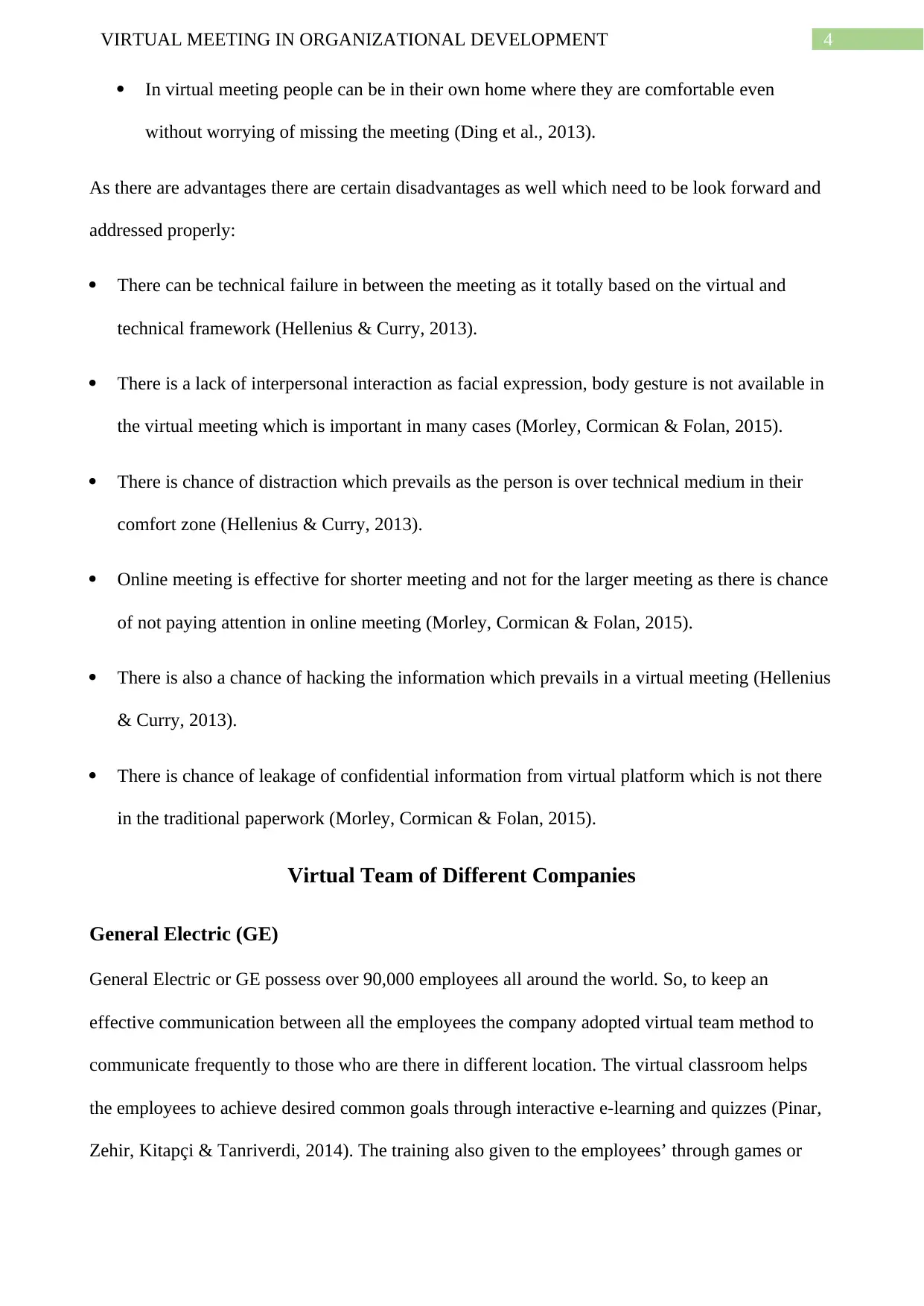
4VIRTUAL MEETING IN ORGANIZATIONAL DEVELOPMENT
In virtual meeting people can be in their own home where they are comfortable even
without worrying of missing the meeting (Ding et al., 2013).
As there are advantages there are certain disadvantages as well which need to be look forward and
addressed properly:
There can be technical failure in between the meeting as it totally based on the virtual and
technical framework (Hellenius & Curry, 2013).
There is a lack of interpersonal interaction as facial expression, body gesture is not available in
the virtual meeting which is important in many cases (Morley, Cormican & Folan, 2015).
There is chance of distraction which prevails as the person is over technical medium in their
comfort zone (Hellenius & Curry, 2013).
Online meeting is effective for shorter meeting and not for the larger meeting as there is chance
of not paying attention in online meeting (Morley, Cormican & Folan, 2015).
There is also a chance of hacking the information which prevails in a virtual meeting (Hellenius
& Curry, 2013).
There is chance of leakage of confidential information from virtual platform which is not there
in the traditional paperwork (Morley, Cormican & Folan, 2015).
Virtual Team of Different Companies
General Electric (GE)
General Electric or GE possess over 90,000 employees all around the world. So, to keep an
effective communication between all the employees the company adopted virtual team method to
communicate frequently to those who are there in different location. The virtual classroom helps
the employees to achieve desired common goals through interactive e-learning and quizzes (Pinar,
Zehir, Kitapçi & Tanriverdi, 2014). The training also given to the employees’ through games or
In virtual meeting people can be in their own home where they are comfortable even
without worrying of missing the meeting (Ding et al., 2013).
As there are advantages there are certain disadvantages as well which need to be look forward and
addressed properly:
There can be technical failure in between the meeting as it totally based on the virtual and
technical framework (Hellenius & Curry, 2013).
There is a lack of interpersonal interaction as facial expression, body gesture is not available in
the virtual meeting which is important in many cases (Morley, Cormican & Folan, 2015).
There is chance of distraction which prevails as the person is over technical medium in their
comfort zone (Hellenius & Curry, 2013).
Online meeting is effective for shorter meeting and not for the larger meeting as there is chance
of not paying attention in online meeting (Morley, Cormican & Folan, 2015).
There is also a chance of hacking the information which prevails in a virtual meeting (Hellenius
& Curry, 2013).
There is chance of leakage of confidential information from virtual platform which is not there
in the traditional paperwork (Morley, Cormican & Folan, 2015).
Virtual Team of Different Companies
General Electric (GE)
General Electric or GE possess over 90,000 employees all around the world. So, to keep an
effective communication between all the employees the company adopted virtual team method to
communicate frequently to those who are there in different location. The virtual classroom helps
the employees to achieve desired common goals through interactive e-learning and quizzes (Pinar,
Zehir, Kitapçi & Tanriverdi, 2014). The training also given to the employees’ through games or
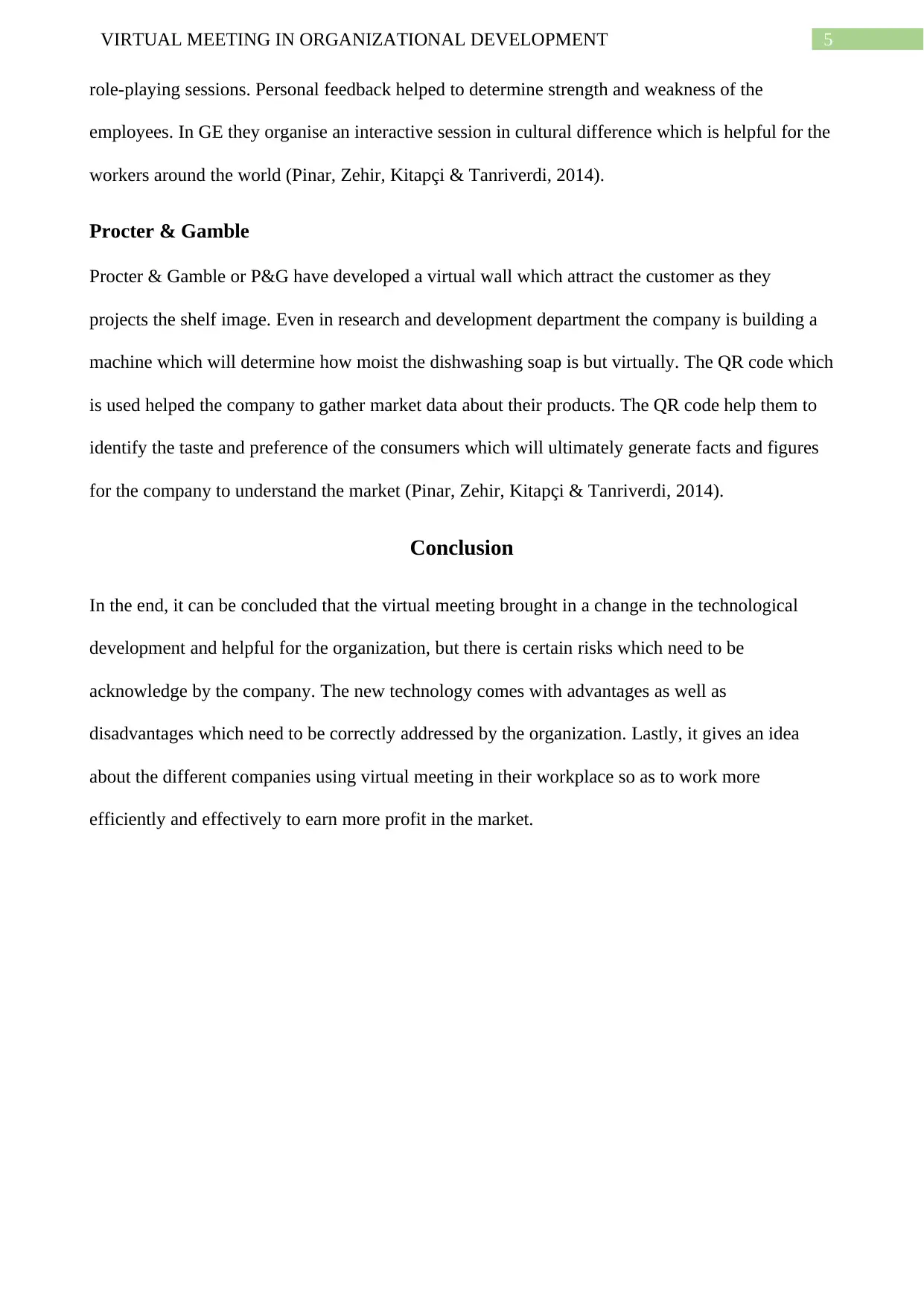
5VIRTUAL MEETING IN ORGANIZATIONAL DEVELOPMENT
role-playing sessions. Personal feedback helped to determine strength and weakness of the
employees. In GE they organise an interactive session in cultural difference which is helpful for the
workers around the world (Pinar, Zehir, Kitapçi & Tanriverdi, 2014).
Procter & Gamble
Procter & Gamble or P&G have developed a virtual wall which attract the customer as they
projects the shelf image. Even in research and development department the company is building a
machine which will determine how moist the dishwashing soap is but virtually. The QR code which
is used helped the company to gather market data about their products. The QR code help them to
identify the taste and preference of the consumers which will ultimately generate facts and figures
for the company to understand the market (Pinar, Zehir, Kitapçi & Tanriverdi, 2014).
Conclusion
In the end, it can be concluded that the virtual meeting brought in a change in the technological
development and helpful for the organization, but there is certain risks which need to be
acknowledge by the company. The new technology comes with advantages as well as
disadvantages which need to be correctly addressed by the organization. Lastly, it gives an idea
about the different companies using virtual meeting in their workplace so as to work more
efficiently and effectively to earn more profit in the market.
role-playing sessions. Personal feedback helped to determine strength and weakness of the
employees. In GE they organise an interactive session in cultural difference which is helpful for the
workers around the world (Pinar, Zehir, Kitapçi & Tanriverdi, 2014).
Procter & Gamble
Procter & Gamble or P&G have developed a virtual wall which attract the customer as they
projects the shelf image. Even in research and development department the company is building a
machine which will determine how moist the dishwashing soap is but virtually. The QR code which
is used helped the company to gather market data about their products. The QR code help them to
identify the taste and preference of the consumers which will ultimately generate facts and figures
for the company to understand the market (Pinar, Zehir, Kitapçi & Tanriverdi, 2014).
Conclusion
In the end, it can be concluded that the virtual meeting brought in a change in the technological
development and helpful for the organization, but there is certain risks which need to be
acknowledge by the company. The new technology comes with advantages as well as
disadvantages which need to be correctly addressed by the organization. Lastly, it gives an idea
about the different companies using virtual meeting in their workplace so as to work more
efficiently and effectively to earn more profit in the market.
⊘ This is a preview!⊘
Do you want full access?
Subscribe today to unlock all pages.

Trusted by 1+ million students worldwide
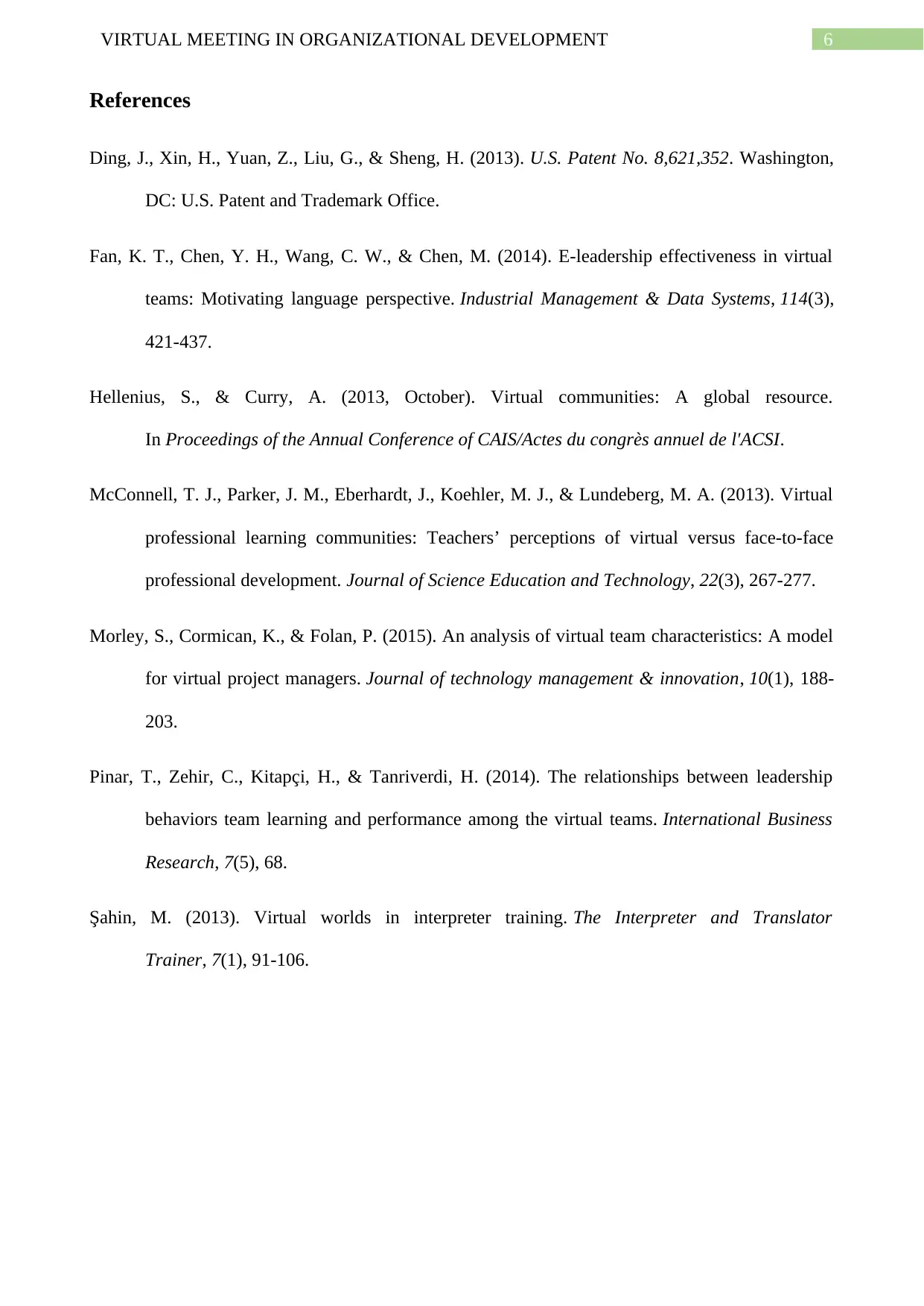
6VIRTUAL MEETING IN ORGANIZATIONAL DEVELOPMENT
References
Ding, J., Xin, H., Yuan, Z., Liu, G., & Sheng, H. (2013). U.S. Patent No. 8,621,352. Washington,
DC: U.S. Patent and Trademark Office.
Fan, K. T., Chen, Y. H., Wang, C. W., & Chen, M. (2014). E-leadership effectiveness in virtual
teams: Motivating language perspective. Industrial Management & Data Systems, 114(3),
421-437.
Hellenius, S., & Curry, A. (2013, October). Virtual communities: A global resource.
In Proceedings of the Annual Conference of CAIS/Actes du congrès annuel de l'ACSI.
McConnell, T. J., Parker, J. M., Eberhardt, J., Koehler, M. J., & Lundeberg, M. A. (2013). Virtual
professional learning communities: Teachers’ perceptions of virtual versus face-to-face
professional development. Journal of Science Education and Technology, 22(3), 267-277.
Morley, S., Cormican, K., & Folan, P. (2015). An analysis of virtual team characteristics: A model
for virtual project managers. Journal of technology management & innovation, 10(1), 188-
203.
Pinar, T., Zehir, C., Kitapçi, H., & Tanriverdi, H. (2014). The relationships between leadership
behaviors team learning and performance among the virtual teams. International Business
Research, 7(5), 68.
Şahin, M. (2013). Virtual worlds in interpreter training. The Interpreter and Translator
Trainer, 7(1), 91-106.
References
Ding, J., Xin, H., Yuan, Z., Liu, G., & Sheng, H. (2013). U.S. Patent No. 8,621,352. Washington,
DC: U.S. Patent and Trademark Office.
Fan, K. T., Chen, Y. H., Wang, C. W., & Chen, M. (2014). E-leadership effectiveness in virtual
teams: Motivating language perspective. Industrial Management & Data Systems, 114(3),
421-437.
Hellenius, S., & Curry, A. (2013, October). Virtual communities: A global resource.
In Proceedings of the Annual Conference of CAIS/Actes du congrès annuel de l'ACSI.
McConnell, T. J., Parker, J. M., Eberhardt, J., Koehler, M. J., & Lundeberg, M. A. (2013). Virtual
professional learning communities: Teachers’ perceptions of virtual versus face-to-face
professional development. Journal of Science Education and Technology, 22(3), 267-277.
Morley, S., Cormican, K., & Folan, P. (2015). An analysis of virtual team characteristics: A model
for virtual project managers. Journal of technology management & innovation, 10(1), 188-
203.
Pinar, T., Zehir, C., Kitapçi, H., & Tanriverdi, H. (2014). The relationships between leadership
behaviors team learning and performance among the virtual teams. International Business
Research, 7(5), 68.
Şahin, M. (2013). Virtual worlds in interpreter training. The Interpreter and Translator
Trainer, 7(1), 91-106.
1 out of 7
Related Documents
Your All-in-One AI-Powered Toolkit for Academic Success.
+13062052269
info@desklib.com
Available 24*7 on WhatsApp / Email
![[object Object]](/_next/static/media/star-bottom.7253800d.svg)
Unlock your academic potential
Copyright © 2020–2025 A2Z Services. All Rights Reserved. Developed and managed by ZUCOL.



